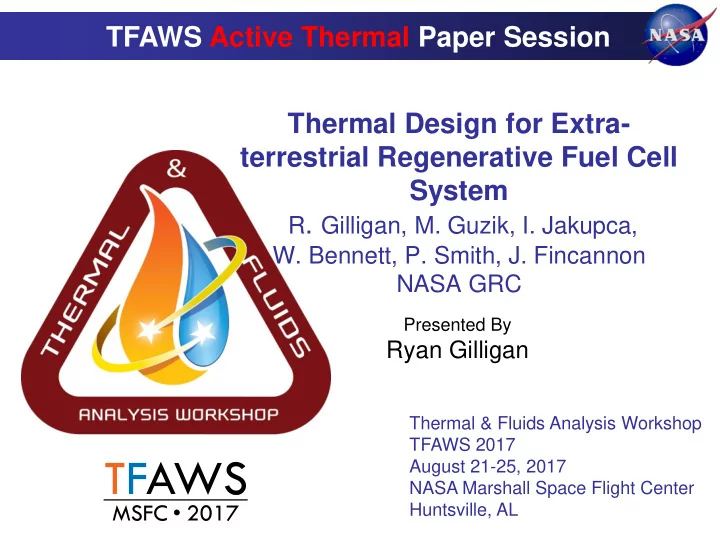

TFAWS Active Thermal Paper Session Thermal Design for Extra- terrestrial Regenerative Fuel Cell System R . Gilligan, M. Guzik, I. Jakupca, W. Bennett, P. Smith, J. Fincannon NASA GRC Presented By Ryan Gilligan Thermal & Fluids Analysis Workshop TFAWS 2017 TFAWS August 21-25, 2017 NASA Marshall Space Flight Center MSFC ∙ 2017 Huntsville, AL
AMPS Fuel Cell Trade Study • The Advanced Exploration Systems- Advanced Modular Power Systems (AMPS) Fuel Cell Program performed a trade study between two fuel cell chemistries for a surface power system on either the Moon or Mars • Fuel cell chemistries: proton exchange membrane fuel cell (PEMFC) and solid oxide fuel cell (SOFC) • Four locations were considered: the Martian equator, the Jezero Crater on Mars (18 deg north latitude), the lunar equator, and the lunar south pole • The goal of the trade study was to determine which FC chemistry is best suited for each application – Figures of merit: RFC mass, volume, round trip efficiency, and electric charge power required – Secondary goal is to identify technologies requiring further development TFAWS 2017 – August 21-25, 2017 2
Regenerative Fuel Cell Systems • Regenerative fuel cell (RFC) – Energy storage device – Utilizes a fuel cell to provide power and an electrolyzer to recharge • Fuel cell – Electrochemical device that converts a fuel (hydrogen) and oxidizer (oxygen) into electricity and heat • Electrolyzer – Electrochemical device that requires electricity to convert water to hydrogen and oxygen gas • RFC surface power system concept – Use solar arrays during the day to provide customer power and recharge RFC – Use fuel cell stack to provide power during night time or eclipse TFAWS 2017 – August 21-25, 2017 3
PEM Technology Anode Cathode (Hydrogen) (Oxygen) ½ g O 2 + 2H + + 2 e - → H 2 O g H 2 → 2H + + 2e - • Operating temperature: 60 to 80 C • Operating pressure: 40 to 50 psia 2 𝐼 2 + 𝑃 2 → 2 𝑚 𝐼 2 𝑃 + 4𝑓 − + 𝐼𝑓𝑏𝑢 4 Ref 1
SOFC Technology • Ceramic electrolyte conducts oxygen anions across the cell • Operates at high temperatures 600 C to 1000 C • Operates at low pressures around 14.7 psia https://en.wikipedia.org/wiki/Solid_oxide_fuel_cell http://www.refractories.saint-gobain.com/markets/energy-solid-oxide-fuel-cells TFAWS 2017 – August 21-25, 2017 5
Thermal Requirements – PEM System 1. Reject waste heat produce by fuel cell and electrolyzer • FC considered produced 10 kW of electrical power and 7.6 kW of waste heat • Electrolysis is much more efficient and only produces around 1.5 kW of waste heat for 23 kW of input power 2. Minimize thermal cycling of fuel cell and electrolyzer • On/off cycles lead to degradation in fuel cell performance and reduce life of stack due to mechanical stresses resulting in delamination of the polymer membrane and catalyst [Ref 2] 3. Avoid freezing of liquid water in system • PEM electrolyte (Nafion) is hydrated and is damaged from freezing • Liquid water coolant system used and must not freeze TFAWS 2017 – August 21-25, 2017 6
Notional P&ID of PEM FC RFC TFAWS 2017 – August 21-25, 2017 7
Thermal Requirements – SOFC System 1. Reject waste heat produce by fuel cell and electrolyzer 1. Same as with PEM except SOFC are more efficient and produce less waste heat; however must reject high quality heat 2. Minimize thermal cycling of fuel cell and electrolyzer 1. On/off cycles are much more significant in SOFCs due to the large temperature difference between ambient and operating temperatures 3. Avoid freezing of liquid water in system 1. Must feed either liquid or vapor water to PEM electrolyzer (EZ) 2. Liquid water coolant system used and must not freeze TFAWS 2017 – August 21-25, 2017 8 https://www.nasa.gov/multimedia/imagegallery/image_feature_2059.html http://www.fluitec.ch/mixing-heat-exchanger.html
Notional P&ID of SOFC RFC TFAWS 2017 – August 21-25, 2017 9
SOFC Thermodynamic Analysis TFAWS 2017 – August 21-25, 2017 10
Summary • Key hardware and concepts in PEM thermal system – Deionized water coolant loop • Coolant pump, coolant, coolant tank • Radiator (based on ISS DDCU design) – Use warm coolant to from operational component to maintain the temperature of the offline component – Thermal enclosure to insulate FC, EZ, coolant, and hardware • Key hardware and concepts in SOFC thermal system – Thermodynamic analysis performed to determine temperatures/pressures at different locations – Heat exchangers sized using Q=UA*LMTD – Furnace used to maintain SOFC temperature • High temperature insulation and hermetic hot box to prevent external leakage • Electric heaters used to maintain SOFC temperature while in standby TFAWS 2017 – August 21-25, 2017 11
Trade Study Results Advantage ← SOFC │ PEM → AMPS SAWS Unweighted % Difference Between PEM and SOFC PEM SOFC % Difference TFAWS 2017 – August 21-25, 2017 PEM SOFC 12 2
Technology Development Areas • Water quality – Regenerative deionizing filter bed • Material compatibility – Avoiding corrosion from deionized water • Component Reliability – Martian mission duration considered was over 10 years with rare opportunities for performing maintenance • Water vapor management in electrolyzer effluent – Regenerative dryer technology needed • Fuel cell and electrolyzer stacks – Need for life testing data TFAWS 2017 – August 21-25, 2017 13
QUESTIONS? TFAWS 2017 – August 21-25, 2017 14
References 1. Baker, Ryan and Jiujun Zhang. “Proton Exchange Membrane (PEM) Fuel Cells”. Electrochemistry Encyclopedia. http://electrochem.cwru.edu/encycl/ TFAWS 2017 – August 21-25, 2017 15
Recommend
More recommend